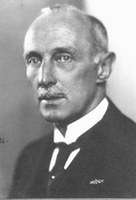Jan van der Hoeve
Jan van der Hoeve (13 April 1878 in Santpoort – 26 April 1952 in Leiden) was a Dutch ophthalmologist. He is recognised for his concept of the phakomatoses, often called neurocutaneous syndromes.

Jan van der Hoeve
Van der Hoeve graduated from the University of Leiden and received his doctorate at the University of Bern. He became a professor of ophthalmology at the University of Groningen and later at the University of Leiden. Van der Hoeve became a member of the Royal Netherlands Academy of Arts and Sciences in 1923.[1] He was elected president of the Physical Section of the institute in 1932.
Van der Hoeve made one of the earliest descriptions of Waardenburg syndrome, in 1916.[2]
Papers
- Van der Hoeve J (1920). "Eye symptoms in tuberous sclerosis of the brain". Trans Ophthalmol Soc UK. 40: 329–334.
gollark: Well, yes, but what's the point of using a bad and obfuscated save file format?
gollark: Look, the CC community mostly goes around writing software for each other's benefit, which anyone can help with. By doing this, you're making it harder for anyone to help you.
gollark: What's the point of that?
gollark: Please stop doing that.
gollark: Why are you *deliberately obfuscating your code*?!
See also
References
- "J. van der Hoeve (1878 - 1952)". Royal Netherlands Academy of Arts and Sciences. Retrieved 18 July 2015.
- Song, J.; Feng, Y.; Acke, F. R.; Coucke, P.; Vleminckx, K.; Dhooge, I. J. (2016). "Hearing loss in Waardenburg syndrome: a systematic review". Clinical Genetics. 89 (4): 416–425. doi:10.1111/cge.12631. ISSN 1399-0004.
- Enersen, Ole Daniel. "Jan van der Hoeve". Who Named It?. Retrieved 2007-07-13.
This article is issued from Wikipedia. The text is licensed under Creative Commons - Attribution - Sharealike. Additional terms may apply for the media files.